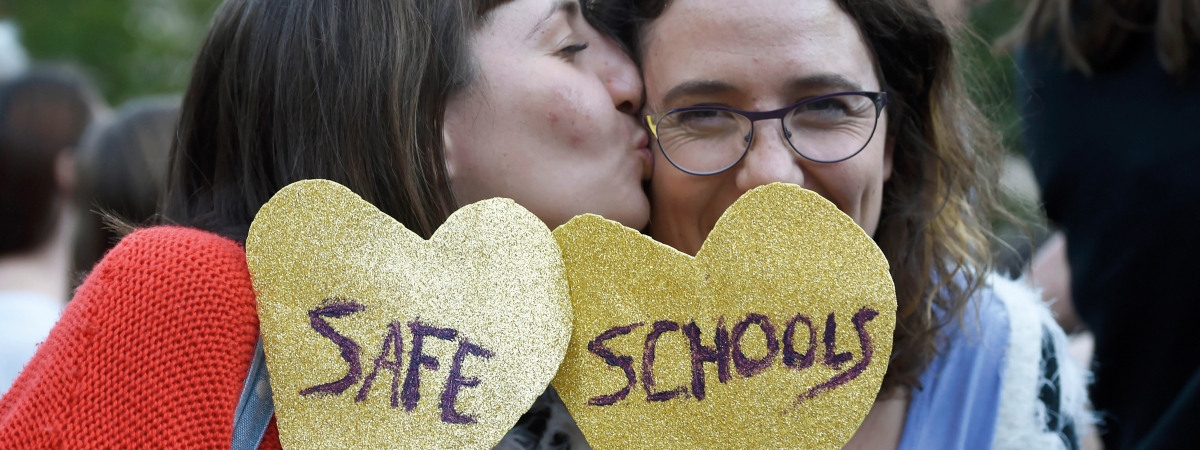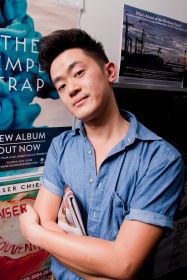A LITTLE LIFE
What makes a thirteen-year-old kill himself?
It was November 2016 in Guangzhou, China, and I found myself asking this question after reading the news from home. Reports were coming in that a kid named Tyrone Unsworth had taken his life in my home state of Queensland. I call him a “kid” for a reason: Unsworth had barely hit his teens. Photographs showed a fair, freckly, curly-haired boy, a sassy moppet who danced and worshipped at the twin altars of Gaga and Beyoncé. Those who knew him told me later that he was the kid doing cartwheels at lunch; the sensitive one who’d tell his teachers, to their faces, that he loved them. For anyone to take their life that young is gutting, but what really got me was how his mother raged that Unsworth had been bullied to death for being gay. The Courier-Mail ran a heart-bruising headline that day: “Mum’s anguish: ‘They ended up getting him.’”
Unsworth’s suicide was front-page news in the state. The story was splashed across the ABC, News Corp’s metro titles and Fairfax’s Brisbane Times. It ran on TV news bulletins across the country and was featured on the ABC’s 7.30 and international outlets in the following weeks. Curiously, though, the story didn’t run in the Australian, the country’s only national broadsheet. In fact, the Australian would never run a single word about Unsworth’s death.
My mind wandered back to the first time I’d set foot in mainland China, half a decade ago, when I’d spent months interviewing young gay women and men in Beijing for a book chapter. There was a lesbian who didn’t even know the word for “gay” until adulthood; a man who’d been overprescribed antidepressants as a teenager to cure him of homosexuality; gay men and women who’d held elaborate sham weddings to fool parents into thinking they were straight. Many told me about the times they’d considered or tried killing themselves. When the book came out, the most common response was pity. Poor China. So backward for queers, especially compared to Australia. Yet here we were.
Another Australian at the Guangzhou conference was the writer Melissa Lucashenko. Like me, Lucashenko is queer and from Queensland; like Unsworth, she’s Indigenous. For queer Indigenous Australians, Unsworth’s suicide was felt even more keenly.
That day, Lucashenko and I sought each other out.
“Did you read the news?”
“Christ, poor kid.”
“Apparently he was gay.”
“Thirteen years old, too.”
The unspoken thought hovered between us: imagine wanting to kill yourself at that age.
Thing is, we probably could.
It might seem self-centred and disingenuous, a performance of false intimacy, to grieve for someone you’ve never met. But if you grew up queer in Australia, Tyrone Unsworth’s suicide felt personal. At Unsworth’s age, I attended a school where – as in most Australian schools, I’d venture – being gay was one of the worst things you could be. Some would argue it is the worst. After all, it still has the strange honour of being the only identity ascribed to anything in the schoolyard deemed to be shit.
If you grew up queer in Queensland, your experience was likely tougher still. After New South Wales decriminalised homosexuality in 1984, Queensland dug in its heels the year after and attempted to pass an amendment to the Liquor Act banning bars from serving “perverts” and “deviants.” Earning its reputation as Australia’s “Deep North,” it was the last mainland state to make gay sex legal.
Every push for the protection of queers in Australia has been accompanied by a jeering soundtrack of loathing. For some commentators, howling down queer activists is something of a family tradition. In 1994 columnist Frank Devine wrote in the Australian of Tasmanian efforts to decriminalise gay sex, that “one must deplore the arrogance and meretriciousness of the effort by homosexuals to have [these laws] rescinded.” A generation later, his daughter Miranda would take it up a notch in News Corp metro newspapers, advising marriage equality activists to “take our olive branch and shove it where the sun don’t shine.”
In all of this, kids were assumed to be off-limits. However, by the time Unsworth killed himself, the Australian was in its tenth consecutive month of indefatigable, sustained coverage and criticism of Safe Schools Coalition Australia, a federally funded program launched in 2014 to support lesbian, gay, bisexual, transgender, intersex and queer school students. SSCA was inexpensive – $8 million over three years (by contrast, the National School Chaplaincy Programme cost $243.8 million over four years) – and designed to address long-documented higher rates of abuse, suicide and self-harm. Independent studies consistently show LGBTIQ Australians have the highest rates of suicidality of any demographic in the country. When it was launched, Safe Schools was largely seen as a political no-brainer. These were kids, after all.
That changed in February 2016, when the Australian ran its first front-page story excoriating the Safe Schools program. (Its headline: “Activists push taxpayer-funded gay manual in schools.”) Within hours of the story, Safe Schools was being debated in parliament. Within days, Coalition backbenchers had pledged to destroy it. Within a fortnight, Prime Minister Malcolm Turnbull requested education minister Simon Birmingham launch a review. After one month, Birmingham confirmed that Safe Schools’ federal funding would not be renewed. That didn’t mean the coverage stopped. As long as Safe Schools continued in any form, so too would stories in News Corp papers.
Like many Australian queers, by November 2016 I was exhausted by the Australian’s coverage of Safe Schools. The suicide of Unsworth – a kid who was likely driven to his death by schoolyard taunts and physical assaults – felt like the last straw. That afternoon in China, in a fog of self-righteous rage, I leapt over China’s firewall and logged onto Twitter, where Australians were already posting about Unsworth. The hot takes had begun. Linking to the Courier-Mail’s story, I added my own:
Tell your kids – no matter how young – that being LGBTIQ is fine, that bullying is torture, and then demand Safe Schools.
I’ll admit it. I felt smug when it was retweeted over 300 times. That’ll show them, I thought. Who I’d shown – and what, exactly – well, clearly, I hadn’t thought that far ahead. In researching this essay, I now see that tweet for what it is: a premature take on something I thought I understood, but actually knew next to nothing about. I’d read a lot about Safe Schools by that stage, mostly in the Australian and its metropolitan sibling titles, but my knowledge of the program had been gleaned from stories I now realise were at best inadequate or misleading, at worst simply false. My tweet, in its own way, was a small drop in a pointless slurry of commentary about Safe Schools, built on shaky foundations, bad faith and half-truths.
Some News Corp journalists would have you believe Safe Schools involved queer activists accessing classrooms and students, without parental consent or knowledge, to teach children about same-sex attraction and transgender people. (Horrifying to some; actually sounds like something I wish I’d had growing up.) Or maybe you heard Queensland MP George Christensen denounce Safe Schools in the Lower House for promoting penis-tucking, chest-binding and gender fluidity to primary-school kids, or for handing them tips on where to buy sex toys online. None of these things was true.
This essay is an attempt at a corrective. We know certain things about Tyrone Unsworth’s life and death. We know he posted about killing himself on social media. We know he was involved in an argument with other teenagers so violent that they broke his jaw. We know he expressed distress over his sexuality. It’s impossible to know whether Safe Schools could have saved Tyrone Unsworth’s life. It very well could have. But what remains now is an opportunity – and arguably the ethical obligation – to take a breath and move beyond tedious queers-versus-parents, activists-versus-moralists trench warfare. To do this, we might need to acknowledge something uncomfortable: that everyone invested in this discussion wants the same thing: to keep kids safe. The conundrum, of course, is that our interpretations of what constitutes the safety of children differ wildly. While members of the Australian Christian Lobby and the anti-same-sex-marriage lobby group Australian Marriage Alliance see Safe Schools as an “extreme ideology” designed merely to “make LGBTI children feel ‘comfortable’” (quote marks theirs), Australian queers are impatient for change, seeing one kid’s suicide attempt as one too many.
Can we agree on a baseline, then? In his 2012 book Far from the Tree, American-British author and journalist Andrew Solomon suggests: “It seems right to prioritise each child’s mental health over a system that makes universal predictions about what should constitute happiness or what values are healthy.” Few of us would argue against this. Yet the past two years of debate over Safe Schools have seen reporters elevate the opinions of zealots (one of whom publicly proclaimed transgender children the work of Satan) and selectively defer to medical and education “experts” who have long histories of expressing anti-gay sentiments in their professional work. Subsequently, some of the most vocal backlash has come from extremists on the other side, including queer activists who’ve raided and trashed the office of a senator, and those who argue any journalist working at News Corp has blood on their hands. (For what it’s worth, I happily wrote for News Corp every week for six years.)
In all the posturing and point-scoring, vital context and nuance have been lost. Who has the time to get their head around the complicated intricacies of departmental bureaucracy when there’s an ideological scrap to be won? Important voices have also been erased, including non-partisan medical experts, education academics and LGBTIQ youth themselves.
This essay is for people who’ve read the stories and suspect – rightly – that there must be more to it. It’s for anyone tired of seeing Safe Schools used as a handy battleground to score points in a bigger culture war. It’s for parents and guardians who’ve read the countless newspaper stories and are still confused. It’s for anyone who wondered why so few Australian kids were engaged in a discussion that was, apparently, about their welfare. It’s for anyone baffled why, in 2017, commentators are still railing against a queer “agenda” or “ideology,” something that would sound anachronistically quaint if it wasn’t so nakedly hateful. But given we’re planning to spend $122 million on a non-binding survey on the rights of our citizens that will be delivered via the post, it’s fair to say we’re fond of strange anachronisms right now.
In the spirit of clearing up confusion, then, let’s start with some facts, and rewind to 2014, when Safe Schools Coalition Australia was being launched – an almost prelapsarian moment. Nowadays Tony Abbott might try valiantly to revise the past, painting Safe Schools as a program lost “down in the bowels of the bureaucracy that the people at the top of the system aren’t aware of.” But let the record show that there was a time when everyone – on both sides of politics, and including him – was seemingly happy to back Safe Schools.
CONTINUE READING
This is an extract from Benjamin Law's Quarterly Essay, Moral Panic 101: Equality, Acceptance and the Safe Schools Scandal. To read the full essay, subscribe or buy the book.
ALSO FROM QUARTERLY ESSAY












